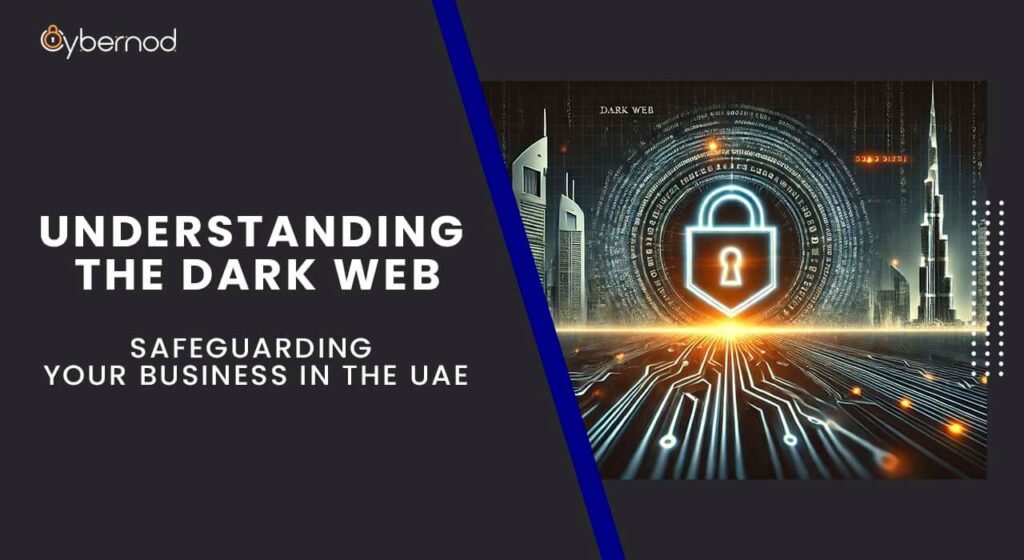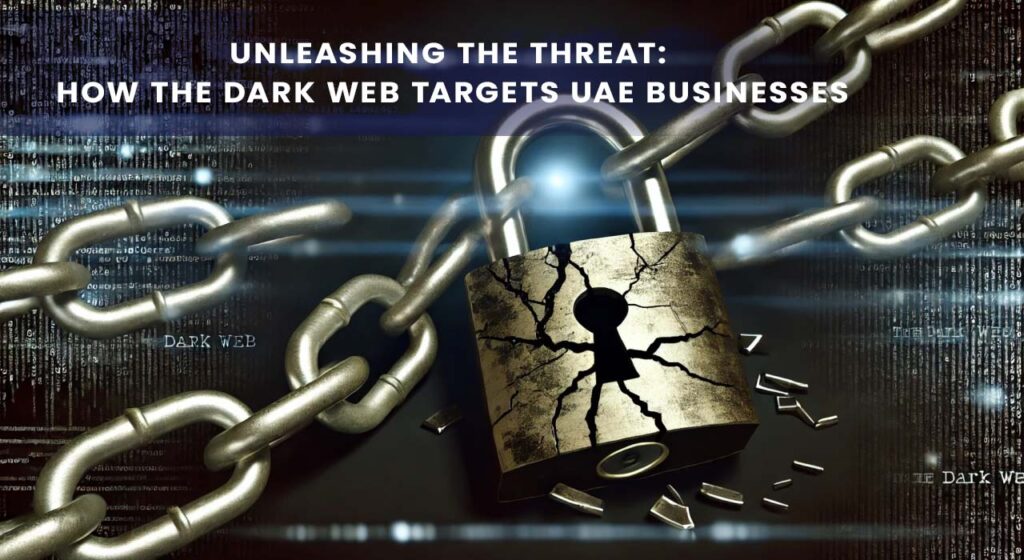
The dark web, a hidden layer of the internet, is increasingly becoming a hub for illicit activities, including the sale of stolen data, compromised credentials, and malware. For businesses in the UAE, this poses a significant threat, as sensitive corporate information can be targeted and exploited. According to cybersecurity experts, approximately 60% of small businesses fail to recover after experiencing a cyberattack, underscoring the importance of comprehensive security measures. Implementing a cybersecurity risk assessment is crucial to identifying vulnerabilities before they are exposed. Small businesses, often perceived as easier targets, are particularly vulnerable, highlighting the need for tailored cybersecurity for small business solutions. The dark web’s role in facilitating these attacks cannot be underestimated, as it enables hackers to trade sensitive data, putting both financial and operational security at risk . By understanding the dark web’s impact, UAE businesses can take proactive steps to secure their data and protect their reputation.
How the Dark Web Impacts UAE Businesses

The dark web presents a growing challenge for businesses in the UAE, particularly with the rise of cyberattacks involving data breaches and credential leaks. Hackers frequently target sensitive business information, ranging from customer data to intellectual property, which is often sold or traded on the dark web. This threat is especially pronounced in sectors such as finance and healthcare, where sensitive records are of high value. A recent UAE report on cybersecurity highlighted that nearly 50% of businesses have experienced a data breach in the last year, emphasizing the pressing need for effective cybersecurity for businesses.
One key vulnerability is the exposure of credentials through phishing attacks, which are then exploited by hacker groups. These attackers use the dark web to monetize stolen data, leaving companies at risk of financial and reputational damage. Conducting a comprehensive security gap analysis can help businesses identify weaknesses in their security posture and mitigate potential risks. This involves assessing both technical vulnerabilities and human factors that could lead to breaches.
The dark web’s accessibility to malicious actors means that businesses of all sizes, including small and medium enterprises (SMEs), must invest in robust security measures. Implementing regular cybersecurity risk assessments ensures that vulnerabilities are addressed before they are exploited. The UAE government has also taken steps to improve cyber resilience through new regulations aimed at protecting critical infrastructure and businesses from these threats.
A visual diagram showing the flow of information from the surface web to the dark web would provide greater clarity on how these threats materialize and the steps businesses can take to protect themselves.
Identifying and Securing Vulnerabilities

Assessing cybersecurity risks is a critical step for businesses in safeguarding their operations against cyber threats. A thorough cybersecurity risk assessment helps organizations identify existing vulnerabilities and prioritize areas that require immediate attention. For UAE businesses, whether large enterprises or SMEs, conducting a cybersecurity assessment is essential to maintaining the integrity of sensitive data and minimizing the risk of breaches.
A key part of this process is performing a security gap assessment, which evaluates the effectiveness of current security measures and highlights weaknesses that could be exploited. This involves analyzing both internal systems and external threats, such as phishing attempts or malware infiltration. For smaller enterprises, selecting the best cybersecurity for small business solutions ensures that even with limited resources, they can address the most critical vulnerabilities effectively. Implementing regular security audits and monitoring can further reduce exposure to risk.
Cybersecurity Risk Assessment Process
| Step | Description |
|---|---|
| 1. Identify Critical Assets | Determine what data and systems are essential to your business. This includes identifying critical infrastructure, intellectual property, customer data, financial information, and other valuable assets. |
| 2. Assess Current Security Measures | Review the existing protocols protecting those assets. This involves evaluating the effectiveness of firewalls, encryption, access controls, incident response plans, and other security measures. |
| 3. Compare Against Best Practices | Benchmark against industry standards and regulatory requirements. This involves comparing your current security practices to recognized frameworks like NIST Cybersecurity Framework, CIS Controls, or ISO 27001. |
| 4. Identify Security Gaps | Pinpoint weaknesses in your current setup. This involves comparing your existing security measures against the identified best practices and identifying areas where there are significant discrepancies. |
| 5. Develop an Action Plan | Prioritize steps to close these gaps. This involves creating a roadmap for implementing new security measures, upgrading existing systems, and addressing identified vulnerabilities. |
| 6. Monitor and Reassess Regularly | Ensure ongoing security improvements. This involves continuously monitoring the effectiveness of implemented security measures, conducting regular reassessments, and staying updated on emerging threats and best practices. |
This structured approach ensures that businesses can proactively address potential threats before they become serious risks.
Dark Web Monitoring and Its Role in Business Protection

Dark web monitoring has become an essential tool for businesses seeking to protect their sensitive data from falling into the wrong hands. As cybercriminals increasingly turn to the dark web to trade stolen credentials, business data, and confidential information, monitoring tools allow companies to detect potential breaches early. These tools continuously scan dark web marketplaces and forums for any mention of a company’s data, providing real-time alerts when compromised information is found.
Dark web monitoring has become an essential tool for businesses seeking to protect their sensitive data from falling into the wrong hands. As cybercriminals increasingly turn to the dark web to trade stolen credentials, business data, and confidential information, monitoring tools allow companies to detect potential breaches early. These tools continuously scan dark web marketplaces and forums for any mention of a company’s data, providing real-time alerts when compromised information is found.
A practical illustration of how dark web monitoring works in real time would show the constant scanning of underground networks, identifying exposed information, and alerting security teams when vulnerabilities are detected. A diagram could effectively demonstrate the continuous nature of this process, highlighting the interaction between scanning algorithms and incident response.
Businesses that invest in dark web monitoring are better equipped to prevent data breaches and respond to threats before they escalate, helping them maintain the trust of their clients and comply with relevant regulations.
Preventive Measures: Best Practices for Cybersecurity

To prevent sensitive business data from being exposed on the dark web, UAE companies must adopt a proactive approach to cybersecurity. Implementing best practices can significantly reduce the risk of cyberattacks and data breaches. One essential step is conducting regular cybersecurity assessments to identify potential vulnerabilities and strengthen defenses. Businesses should also ensure that their systems are up-to-date with the latest security patches and antivirus software.
For small businesses, there are numerous free cybersecurity resources available that offer guidance on how to enhance security without significant financial investment. For instance, the UAE’s Telecommunications and Digital Government Regulatory Authority (TDRA) provides resources for SMEs to safeguard their data. Using these resources, businesses can improve their cybersecurity infrastructure and reduce the likelihood of their information being compromised.
Compliance with local regulations is also critical. UAE cybersecurity laws mandate strict data protection standards, and businesses must comply with cybersecurity regulations to avoid penalties and minimize risks. The UAE Information Assurance Standards (IAS) outline best practices for securing sensitive data, offering clear guidelines for businesses to follow.
To assist with implementation, a checklist summarizing key preventive measures can be valuable:
- Conduct regular cybersecurity risk assessments.
- Use strong, unique passwords and enable multi-factor authentication.
- Ensure that all software is regularly updated with the most recent security patches.
- Provide training to employees on phishing and other forms of social engineering attacks.
- Monitor the dark web for any mention of company credentials or data.
- Use free cybersecurity resources to stay informed about the latest threats.
Following these best practices will help businesses stay ahead of threats and protect their valuable assets from exposure on the dark web.
Why Every Business Needs a Security Gap Analysis
A security gap analysis is a crucial tool for businesses to identify weaknesses in their cybersecurity infrastructure. By conducting a comprehensive gap analysis cyber security, organizations can pinpoint vulnerabilities that may otherwise go unnoticed. This process involves comparing the current state of a company’s security measures against industry standards or regulatory requirements, allowing for a focused improvement strategy.
For UAE businesses, performing a security gap assessment is essential to protect sensitive data and comply with local cybersecurity regulations. The analysis highlights areas where existing security protocols fall short, such as outdated software, weak password practices, or lack of multi-factor authentication. By addressing these gaps, businesses can strengthen their defenses and mitigate the risk of cyberattacks.
Implementing a structured approach to gap analysis enables businesses to stay ahead of emerging threats and maintain strong, proactive cybersecurity practices.
Staying Ahead of Dark Web Threats

Safeguarding business data from dark web threats is critical for UAE companies to avoid financial loss, reputational damage, and regulatory penalties. Continuous cybersecurity risk assessments and regular monitoring are essential to detect vulnerabilities before they can be exploited. By implementing a robust cybersecurity assessment process and leveraging security gap analysis, businesses can stay ahead of emerging threats and mitigate risks effectively. Proactive measures, including dark web monitoring and securing weak points, are fundamental to maintaining a resilient cybersecurity posture. This ongoing vigilance helps ensure that both small and large enterprises remain protected from the evolving threats on the dark web.
For more information on the effectiveness of dark web scanning tools and how to choose the right cybersecurity solutions for your UAE business, please refer to our comprehensive guide, ‘From Exposed Information to Exposed Assets: Securing UAE Companies from Dark Web Threats.’
Protect your business from the growing threats on the dark web. Take immediate action by conducting a comprehensive cybersecurity risk assessment or utilizing dark web monitoring services. Visit Cybernod to ensure your business remains secure and compliant with the latest cybersecurity standards. Don’t wait secure your data today!
Categorized in:
Comments